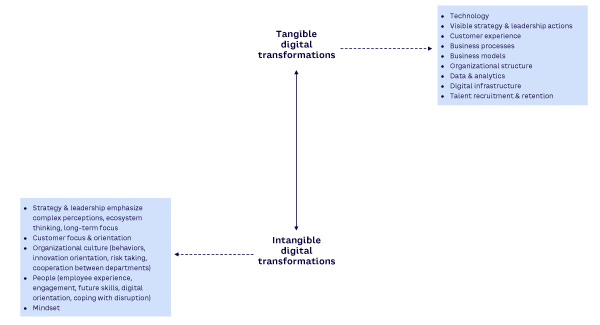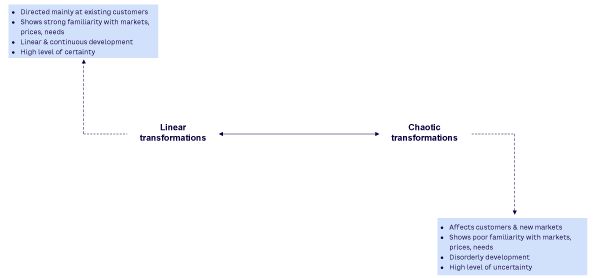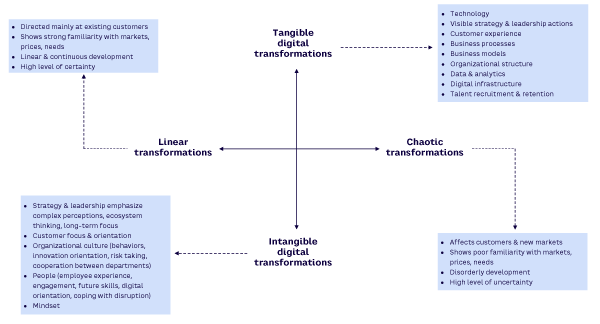LEADERSHIP EXECUTIVE UPDATE VOL. 1, NO. 6

By its very nature, digital transformation involves a bimodal process during which an organization must launch changes at two levels: tangible and intangible. Both types of processes could lead to a disruptive transformation. But there is a second set of actions that must occur along with the tangible and intangible changes: (1) linear, organized exploitation processes and (2) chaotic, disruptive exploration processes. This second pair of changes has increased potential to impact an organization’s path to meeting its goals. As we explore in this Executive Update, the Bimodal Management™ model offers a lens that organizations can use to examine the processes and outcomes as they work toward digital transformation.
Digital capabilities are an imperative in a world racing rapidly toward artificial intelligence, the Internet of Things, blockchain, robotics, quantum computing, and other advanced digital technologies. Any organization striving not only to survive, but also to grow, must respond to the challenges of these disruptions and the changes they bring.
Last year, an issue of Cutter’s Amplify examined technology project failure, illustrating numerous examples of organizations falling short of their objectives. Indeed, as Guest Editor Steve Andriole pointed out in that issue, digital transformation is unsuccessful 70% of the time.
Failing to meet the defined objectives of digital transformation — and the accompanying sense of disappointment — frequently has serious implications for customer experience and an organization’s growth and competitive advantage. Therefore, a critical question every business leader must answer is: how can I increase my organization’s odds of becoming a digital transformation success story?
In this Executive Update, we examine the transitions made by organizations in the digital world using the Bimodal Management™ model as an essential strategy for increasing their odds of success.
Avoiding an Iceberg
Digital transformation is a complex process. It forces an organization to adopt a wide range of change processes in various contexts. The significant disruptions we see today within organizations are not solely digital; they span the entirety of business, management, and cultural awareness changes that must be made to adapt to the digital era. An organization’s success in its digital transformation depends on its ability to successfully and simultaneously launch interrelated changes that have shared implications. For example, Nokia’s failure to respond to Apple and the innovation it introduced with the iPhone was not a technology failure. It was primarily a management failure reflected by Nokia executives being unprepared to step out of their comfort zone and their belief that customers would continue preferring Nokia’s well-known devices to Apple’s devices with their new capabilities.
Bimodal Digital Transformation
Digital transformation, like any complex process, is also a bimodal process. The Bimodal Management model distinguishes between two types of seemingly contradictory processes — tangible and intangible — at work in the complex realm of digital transformation.
Tangible processes create structured, overt, and visible changes and include:
-
Integrating essential technology
-
Adapting operational processes and supply chains
-
Changing the business model
-
Selecting investment and innovation ventures
-
Changing additional structures and strategies
Intangible processes are abstract, covert, and invisible. They include:
-
Changing perceptions, awareness, and mindsets
-
Addressing fear and objection to change
-
Encouraging managerial courage and risk taking
-
Nurturing an innovative spirit
-
Changing organizational culture
-
Emphasizing a faster decision-making processes
Both processes occur simultaneously when a company shifts into digital mode, as illustrated in Figure 1. Together, these two sets of actions make up the transformation process. Like an iceberg, the small, visible tip appears above the water, while the bigger part remains hidden beneath the water.

While tangible transformations pose a significant challenge for any organization, the fact that they are concrete, predictable, planned, and measured ensures a greater level of control and certainty. This explains why most organizations tend to focus on them. Like the tip of an iceberg, these changes are quite visible.
In contrast, intangible transformations refer to unstructured changes and, in principle, are difficult to plan and measure. These changes are similar to the hidden depths of an iceberg. Given that these processes are characterized by a high level of ambiguity and uncertainty, many organizations have difficulty managing them, and may even ignore them.
An organization’s difficulty managing its intangible transformations is expressed as fear, abstention, and late response. Alternatively, taking action could lead to overt innovation initiatives that lack strategy and long-term vision. These initiatives could fail to create deep changes to the organizational culture, ways of doing business, and overall philosophy. Both types of response — stagnation and over-flexibility/over-response — are in and of themselves disruptive factors to how organizations run their businesses to adapt to the digital era. This lack of strategic focus leads to wasted resources, delays a tailored response, and puts the organization at risk by negatively impacting its strength.
Many organizations spring into action to jump-start tangible transformations, while ignoring or denying the intangible changes. The Bimodal Model asserts that the intangible component of the digital transformation is just as critical as the tangible component. Thus, it must be managed strategically and systematically. The odds of an organization meeting the goals of its digital journey depend on the degree to which it is able to strategically manage both the tangible and intangible dimensions of the digital transformation.
The Bimodal Management model posits that the success of an organization’s digital transformation depends on its ability to concurrently and strategically manage both tangible and intangible transformations, leading to a holistic, organization-wide process, which increases its odds of success and its ability to meet its objectives.
Navigating Order & Chaos
The Bimodal Management model reveals another duality of digital transformation, as it distinguishes between a second series of actions: linear, or orderly processes, and chaotic processes. All organizations must navigate these in order to survive and thrive in the complex and disruptive digital business arena. Though seemingly contradictory, both order and chaos enable the organization to adapt successfully to the digital era and must be embraced. Figure 2 explicitly shows how each transformation could manifest itself.

Linear transformation and innovation processes are development processes that focus on improving products as well as the organization’s current business model. They are designed to respond to the needs of the business’s traditional customer base. Clayton Christensen, the architect of disruptive innovation theory, called these types of processes “sustaining innovation.” Linear processes, also known as “exploitation processes,” focus on exploiting the existing business model and are characterized by a relatively high level of organization, planning, certainty, and control.
Chaotic transformation and innovation processes focus on developing new business models, products, and services that are outside the core business or the organization’s existing business model. These ideas are directed at new and unknown territories and market segments. Christensen called these types of processes “disruptive innovation.” By their nature, these are exploration processes, with an entrepreneurial, chaotic character, and they typically have a low level of certainty and a correspondingly high chance of failure. Chaotic transformation and innovation can result in developments with the potential to disrupt the market in a given field and beyond.
Many organizations, particularly incumbents and hierarchical ones, avoid initiating disruptive processes. They tend to focus on linear transformations and innovation processes within the organization’s comfort zone, which do not undermine basic assumptions or known business processes. These organizations often tend to reject and even ignore the need for disruptive innovation processes. The risk for these organizations is a disruption that will hit them at one point or another through smart technologies. Thus, these disruptions might catch the organization unprepared, capture part of its market share, and force it to search for new markets to survive.
Both linear and chaotic processes are currently essential for organizations to grow in the disruptive market. Each requires a different, and sometimes conflicting, set of abilities and skills. While exploitation processes are stabilizing, exploration processes undermine the organization and pose new and unanticipated risks.
Conclusion
The transition to the digital world appears to have dual potential for organizations, on the one hand providing new growth opportunities, while on the other presenting a source of disruption.
Therefore, we need to view digital transformation as a bimodal process. To succeed, an organization needs to concurrently launch two seemingly conflicting types of processes: linear and organized exploitation processes at the same time as chaotic and disruptive exploration processes.
According to the Bimodal Management model, the four processes — tangible, intangible, organized, and chaotic — present the types of changes an organization must launch successfully to undergo successful digital transformation. Figure 3 identifies potential outcomes and results for each.

Each of the four types of changes is a transformation in and of itself for the organization. By their very nature, organizations and managers tend to focus on the transformations that are linear and tangible, where the degree of certainty and control is higher. And they tend to neglect the chaotic and intangible transformations that are disruptions that threaten the business.
The Bimodal Management model proposes that an organization’s success in shifting to the digital world depends on its ability to manage all four types of transformations — tangible and intangible, linear and chaotic — simultaneously, strategically, and in a balanced manner.




